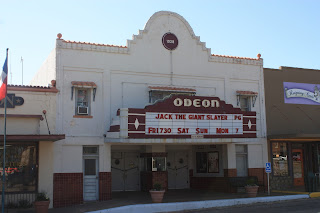"Lone Star Historian" is a blog about the travels and activities of the State Historian of Texas. Bill O'Neal was appointed to a two-year term by Gov. Rick Perry on August 22, 2012, at an impressive ceremony in the State Capitol. Bill is headquartered at Panola College (www.panola.edu) in Carthage, where he has taught since 1970. For more than 20 years Bill conducted the state's first Traveling Texas History class, a three-hour credit course which featured a 2,100-mile itinerary. In 2000 he was awarded a Piper Professorship, and in 2012 he received the Lifetime Achievement Award from the Wild West Historical Association. Bill has published over 40 books, almost half about Texas history subjects, and in 2007 he was named Best Living Non-Fiction Writer by True West Magazine.
Since assuming the office of State Historian I've wanted to host a history conference at Panola College in Carthage. I taught history for four decades at Panola, and as State Historian I have been provided an office and financial backing by the college. Dr. Gregory Powell, President of Panola College, and Vice President Dr. Joe Shannon have graciously afforded me institutional affiliation and constant encouragement. One of my goals as State Historian is to bring an historical event to my home campus.
A number of my books and articles have explored the subject of frontier violence, and I have been invited to speak on this topic throughout the West. These activities have shown me the widespread interest in various aspects of this subject. Nothing is more dramatic than life and death conflict, and when that conflict occurs in a frontier setting, there is a special appeal for many Americans. Of course, gunfighting is generally regarded as an activity of the Wild West. But in reality there were frontier-style shootouts, horseback desperados, violent bank robberies, and murderous blood feuds in 19th-century East Texas.
 "Gunfights and Blood Feuds of Old East Texas" was scheduled for Saturday morning, June 29, at Panola College. The college provided facilities, publicity, refreshments, and other necessary support. I enlisted a longtime friend and award-winning author, Chuck Parsons. Chuck and I have appeared together at a number of similar events. With another friend, Norm Brown, Chuck has co-authored A Lawless Breed, an excellent biography of John Wesley Hardin. A notorious gunfighter, Wes Hardin was a native of East Texas, and a majority of his shootouts occurred in this region. A Lawless Breed was released last month by North Texas Press, and Chuck readily agreed to share with us the latest about Hardin's exploits in East Texas.
"Gunfights and Blood Feuds of Old East Texas" was scheduled for Saturday morning, June 29, at Panola College. The college provided facilities, publicity, refreshments, and other necessary support. I enlisted a longtime friend and award-winning author, Chuck Parsons. Chuck and I have appeared together at a number of similar events. With another friend, Norm Brown, Chuck has co-authored A Lawless Breed, an excellent biography of John Wesley Hardin. A notorious gunfighter, Wes Hardin was a native of East Texas, and a majority of his shootouts occurred in this region. A Lawless Breed was released last month by North Texas Press, and Chuck readily agreed to share with us the latest about Hardin's exploits in East Texas.
Chuck and I greeted a lively crowd numbering nearly 100. I began the vicarious action with an account of the Regulator-Moderator War, fought in our back yard from 1840-1844. The Regulator-Moderator War was the first blood feud in Texas, and the largest in scale, with 200 Regulators and 100 Moderators maneuvering against each other in Shelby County in 1844. I also related the 1869 death of desperado Cullen Baker, who was buried in Jefferson, and an 1884 street shootout in Nacogdoches involving Sheriff A.J. Spradley. The 1879 shooting of actor Maurice Barrymore in Marshall brought unwanted attention to East Texas across the nation and in Europe. Headlines across Texas in February 1888 were dominated by a grisly robbery-murder-lynching in Carthage, involving the county treasurer and a deputy sheriff - and a large lynch mob. In 1894 Bill Dalton led a gang to Longview to rob the First National Bank, and a wild street battle erupted.
 A highlight of the morning was Chuck's presentation of Wes Hardin. There also was considerable interest in my demonstration of the evolution of revolving pistols and holsters. Chuck and I both autographed books, and we enjoyed visiting with fellow aficionados of frontier violence. It was a most enjoyable event, and a number of attendees expressed interest in a future conference.
A highlight of the morning was Chuck's presentation of Wes Hardin. There also was considerable interest in my demonstration of the evolution of revolving pistols and holsters. Chuck and I both autographed books, and we enjoyed visiting with fellow aficionados of frontier violence. It was a most enjoyable event, and a number of attendees expressed interest in a future conference.










.JPG)







.JPG)





















